
Location: Historic American Sheet Music Collection, Duke University, Durham, North Carolina
Title of Song: I’m from Missouri and You Gotter Show Me
Composer: Vanderpool, Fred
Illustrator: Leff
Publisher: M. Witmark
Year & Date: 1902, New York, New York
Collection/Call Number/Copies: Music #B-625
Historic American Sheet Music Item #: b0625
Basic Description
The full-body profile of a well-dressed African American woman is shown before a highly abstracted townscape in the distance. The ribbons on her hat and cape flutter behind her and her torso is bent forward into a stride. The navy, black, and white colors of her dress give her a serious, reserved air, but the white hand muff at her backside exaggerates the curviness of her form. From the tip of her hat to the point of her shoe, her body is a wave of curves–draped artfully in fabric–that resists becoming seductive. The blue stripes that fill the border and form the sky pulse against the pattern of tiny squares that comprise the abstracted townscape. There is an energy and vitalism in this contrasting pattern that the townscape itself seems to lack.
Personal Description
The song itself is about an African American lady from Missouri who moves to a new town and meets a womanizing African American man, from whose perspective the story is told. The story ends with the “western” lady telling him to get lost. The self-possessed appearance of the woman in the illustration, however, makes the bigoted lyrics of the song seem like a non-sequitur. The woman’s dress is fancy and feminine, but its colors, her veil, and her composure imply dignity and reserve. She is attractive and seems cosmopolitan. There is nothing visibly degrading or caricatured about her. Thus the racist references to African American men in the lyrics have a disruptive and almost random quality. Is the cover image a stereotype of a different order (a haughty African American woman from the “west,” preoccupied with being a lady)? Or does this image resist caricature? If she is intended as a foil to emphasize a caricature about black men, it fails. Monumental, dignified, and self-possessed, the cover image works against the stereotypes of the lyrics inside.
Reality Check
Sissieretta Jones (1869-1933)
Sissiereta Jones was a world-famous soprano who in June 1892, became the first African American to perform at Carnegie Hall in New York City. Touring internationally in the late 1800s and early 1900s, she sang both classical opera and performed in musical comedies with her own troupe.
Born Matilda Sissieretta Joyner on January 5, 1869, in Portsmouth, Virginia, she was the child of Jeremiah Joyner, a pastor, and Henrietta Joyner, a singer in the church choir. After moving with her family to Rhode Island when she was six, Sissieretta began singing in the church choir, which was directed by her father. When only fourteen, she married David Richard Jones, who became her first manager. Later, she formally studied voice at the Providence Academy of Music, the New England Conservatory, and the Boston Conservatory.
Following her New York City debut on April 5, 1888 in Steinway Hall, she was nicknamed “the Black Patti” after being compared to the Italian prima donna Adelina Patti, well-known at the time. The nickname stayed with her throughout her 30-plus year career, although she preferred to be called Madame Jones. During the 1880s and 1890s, Jones performed at Madison Square Garden, Boston’s Music Hall and the World’s Columbian Exposition in Chicago. She first performed at the White House in February 1892 for President Benjamin Harrison and returned to appear before Presidents Grover Cleveland, William McKinley, and Theodore Roosevelt. She also appeared before the British Royal Family. Jones’s international tours took her to the Caribbean, South America, Australia, India and Southern Africa as well as London, Paris, Berlin, Milan, Munich, and St. Petersburg. By 1895 Jones had become the most well known and highly paid African American performer of her day.
In the 1890s, she formed Black Patti’s Troubadours, taking advantage of the popularity of black musical comedies, originally called “coon shows.” Jones sang opera selections and spirituals at the end of the show, rather than closing with the typical cakewalk. The group was one of the most popular shows on American stage, touring throughout the United States; the careers of numerous black performers were launched by their initial appearances with the Black Patti troupe.
African Americans began to see the black musical comedies as reflecting negatively on their race, and the group’s tours wound down, with a 1915 last performance at New York City’s Lafayette Theater. Jones moved back to Providence, Rhode Island and cared for her mother and her two adopted children. Sissieretta Jones died in 1933 at the Rhode Island Hospital in Providence, Rhode Island.
(Source: http://www.blackpast.org)






















